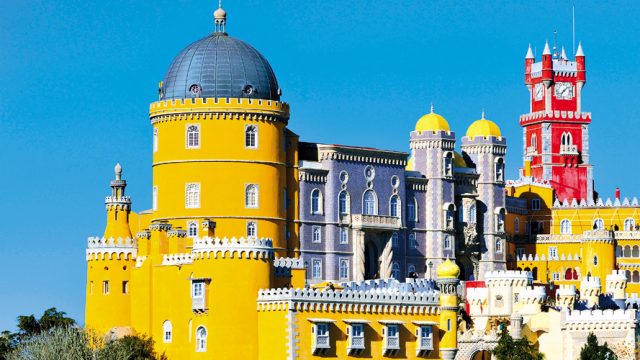Straight out of a Disney movie,” was my first reaction when we rounded a corner and spied the Pena National Palace atop a hill in the distance. Fort walls, towers and minarets reminiscent of a medieval castle, and bright, bold colours that reminded us of fairytale illustrations, this quixotic structure is one of many fascinating sites in Sintra, a town about a hour from Portugal’s capital Lisbon. Built around the 1830s, the Pena Palace served as the summer residence of Portugal’s monarchs in the 18th and 19th centuries.

Situated commandingly above the town, the fortified walls, multiple entrance gates and lookout points testify to it having been a stronghold against any invasion. But the playful, flamboyant architecture, a mix of Gothic, Islamic and other influences, also suggests that it was more than simply a place to keep the royal family safe. The intricate sculpting on the walls reminds one of the ornate Gothic cathedrals that dot many of Europe’s cities. Inside the palace, the living quarters (many rooms open for public view) display furniture, tapestry, carpets, and carvings and paintings on the ceilings, all of which are typical of the expensive and somewhat gaudy tastes of the high-born of those times.

One part of the interiors stands out in stark contrast to the rest: the collection of exquisite line drawings and wood etchings of King Ferdinand II, who was responsible for much of the palace’s early construction. His attention to detail is evident in the depictions of everyday life, of people, dogs, nature.
Given all of this, it is not a surprise that the Pena Palace is a World Heritage Site, and considered one of Portugal’s Seven Wonders.

The walk up to the palace (though one can also drive) from Sintra town is itself rewarding. Through the Liberdidad Park, a botanical garden with some interesting vegetation, then into some lovely forest, there are many vantage points to take in the surrounding landscapes. With a bit of a detour, one can also visit the much older Moorish Castle, now mostly a long, snaking fort wall.

Though more than a thousand years old, going back to the medieval era, it seems to be recent in the context of the history of human occupation here. The first settlers were possibly in the early Paleolithic period (3.3 million to 300,000 years ago), followed by a series of settlements, invasions with uprootings, and resettlements, right up to the present town of Sintra with its residents and ever-growing population of tourists (itself increasingly becoming an invasion!). The town is dominated by the imposing and well-preserved Sintra Palace. It was built in the 15th century and is also part of the World Heritage Site complex. In contrast to its colourful cousin, this palace is sober, the predominantly white walls complemented by tiled brown roofs. But it has its own charm, a combination of Gothic, Manueline (Renaissance), Moorish and Islamic (Mudéjar) architectural styles. It has a fascinating selection of tiles, reflecting the tile-making tradition of the region, with a diversity of motifs and designs going back to when the craft started in 16th-century Portugal under Arabic influence. A painted ceramic tile from one of the souvenir shops is a great buy, presumably helping the local economy and the continuation of an old tradition.

Other sites of interest dot the Sintra complex. The town itself, especially if you escape the crowded main streets, has a unique blend of colours, architecture styles, tiny cafés and shops with local products, art and craftwork on house walls, and other elements that a wanderer not aiming to only tick off the tourist highlights would find of interest. Further up the hillside are sites like the Monserrate Estate, with its Arabic influence. There is an extensive forest area with a mix of Mediterranean and Atlantic plant species (and many exotic ones in the Pena Palace gardens spread over 200 hectares). There is a lot of mountainous terrain to explore, with the 16km-long Sintra Mountains (also called Monte da Lua, or Mountain of the Moon), extending towards the Atlantic Ocean and Cabo da Roca, continental Europe’s most westerly point.

The information
Getting There
There are hopping flights between Delhi and Lisbon, starting from about ₹40,000. To travel to Sintra, 25km west of the Portuguese capital, the best way is by train from Lisbon’s centrally-located Rossio station. The train is cheap, and takes just about an hour (see cp.pt/ passageiros/en). There are also buses available.
What to See & Do
Relevant literature is available at the tourist information centre close to the station in Sintra, as well as online. Architectural sights include a variety of palaces, castles and religious dwellings, such as the Pena National Palace, Sintra National Palace, Convento dos Capuchos and Queluz National Palace. Cabo da Roca is the westernmost point of mainland Europe. There are some nice beaches as well, Praia Grande being the most popular. Much of what we have written about above can be covered in a day trip, but two days are recommended for a more leisurely outing, including delving deeper into the history and nature of the area. There is a variety of accommodation available in Sintra town, including Casa Miradouro (from €90; casamiradouro. com), a 19th-century manor house in the historic centre of Sintra, and the luxurious Hotel Tivoli Palácio de Seteais (from €344; tivolihotels.com), which nestles in the Sintra mountainside and boasts magnificent gardens and a panoramic view. More information is available at visitportugal.co




